Serving Refugees – A Lesson in Collaboration
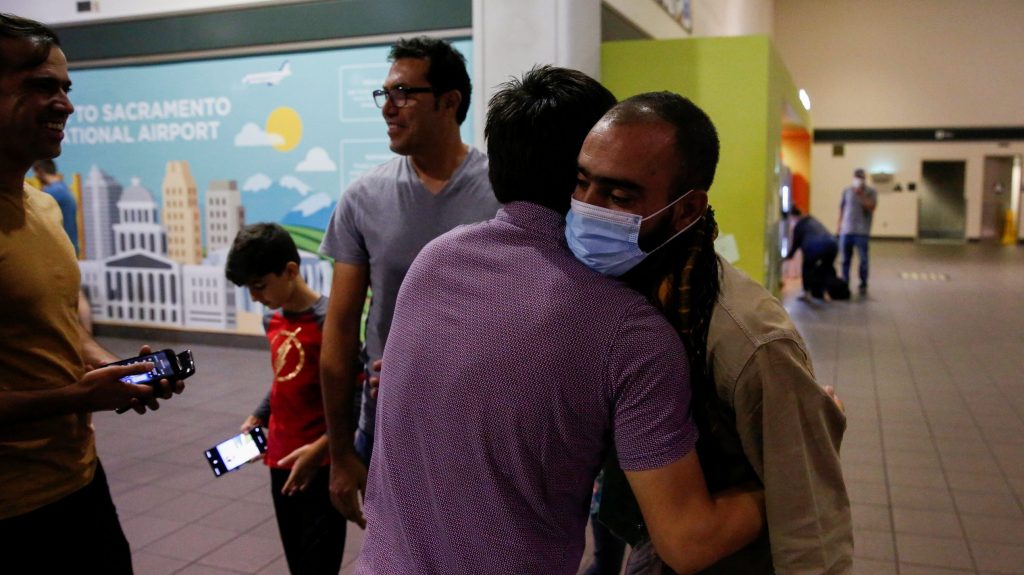
Valley Vision is creating a vibrant and prosperous economy by supporting development of a talented workforce – educated, trained and ready – for the 21st Century economy. The current wave of Afghan refugees has drawn attention to how these new arrivals are integrated into our local workforce system. A refugee is a person living outside of his or her country of nationality who is unable or unwilling to return because of persecution, or a well-founded fear of persecution on account of race, religion, nationality, membership in a particular social group, or political opinion. The Sacramento region resettles a large number of refugees each year and is considered one of eight refugee impacted counties in California. Our region has begun receiving what is expected to be approximately 1,600 refugees, including Special Immigrant Visa holders, in the coming months.
A Collaborative Approach
In California, refugee programs are administered through the Refugee Programs Bureau (RPB), a division of the Department of Social Services. In a uniquely collaborative arrangement, goals are achieved by partnering with counties, workforce boards, nonprofits, school districts, faith-based, ethnic and community organizations. Each County Board of Supervisors determines which agency within the county governmental structure will be responsible for administering the refugee programs. Most often the County Welfare Department (CWD) is the designated agency. However, in Sacramento, there is a unique partnership between the CWD that oversees the delivery of public assistance, and the Sacramento Employment and Training Agency (SETA), which oversees the delivery of employment and acculturation services and overall refugee program coordination. Since 1983, SETA has been responsible for planning, coordinating and managing grant funds allocated to the county to provide refugee-specific employment services. The local resettlement agencies regularly convene forums open to refugees, service organizations and other stakeholders, in an effort to continuously collaborate and improve upon services.
The Refugee Experience
When refugees first arrive at the Sacramento International Airport, they are greeted by representatives from one of five local resettlement agencies; Sacramento Food Bank and Family Services, Opening Doors Inc. Sacramento, Lao Family Community Development Inc., World Relief Sacramento and International Rescue Committee. These agencies provide welcome, resources and introduction to services to help individuals and families survive and acclimate for their first 90 days in the country. Shortly before the arrival of the refugees, the resettlement agencies arrange for their housing, which includes basic furnishings, appliances, climate-appropriate clothing, and some food typical of the refugees’ culture. After arrival, resettlement agencies help refugees start their lives in the U.S., assisting them with applying for a Social Security card, registering children in school, learning how to access shopping facilities, arranging medical appointments, and connecting them with needed social, employment and language services.
Refugee status is accompanied by employment authorization and refugees are expected to become employed quickly in order to afford the high cost of living in our region and to begin repaying their loans to travel to the U.S., which can cost thousands of dollars. These conditions make employment attainment essential to the well-being of refugee families. SETA works with a number of community based organizations, school districts and resettlement agencies to assist refugees with transitioning to employment as quickly as possible. Services provided include Vocational English as a Second Language training, employment placement services, on the job training, navigator services, social adjustment and cultural orientation. A full list of refugee employment service providers is located on SETA’s website.
Of the more than 20 million refugees of concern to the United Nations, less than 1% are resettled each year. Although historically the U.S. has resettled more refugees than other country, its resettlement program has waned recently with the most recent fiscal year having the lowest U.S. refugee limit since 1980. Each year the number accepted to the U.S. is set by the President in consultation with Congress. Additional information on this most recent wave of refugees, refugee resettlement and services is available at the following links: California’s Afghan Arrival Response, videos on the Refugee Resettlement experience, and the Sacramento Region’s local services. Creating inclusive opportunities for the regional refugee community is a critical function of our workforce system, and the collaborative efforts of these partners are critical to ensuring a high quality of life for these populations.
To keep up with Valley Vision’s work to advance a future-ready workforce in the Sacramento region, subscribe to our 21st Century Workforce email newsletter!”
Renee John is a Valley Vision Project Leader managing initiatives within the 21st Century Workforce impact area.
Investing In Our Region

New, historic investments in regional economic recovery present our region with the opportunity to rebuild and grow, with a commitment to community and equity at the center of it. What have we done, and what must we do to take advantage?
This summer, we are seeing historic financial commitments to infrastructure, economic, environmental, and community resilience through both state and federal government channels. Just yesterday, the U.S. Senate passed a $1 trillion dollar infrastructure bill that will support expanded high speed internet access, roads, bridges, airports, Amtrak, and more. This will be the largest infusion of infrastructure investments in more than a decade and will certainly be felt within our region as those dollars get deployed across the country. In addition to infrastructure dollars, we have seen a significant commitment to recovery and community investment from both the Coronavirus Aid, Relief, and Economic Security Act (CARES), starting in 2020, and the American Rescue Plan Act (ARPA), passed in February 2021. The ARPA funds, which are just beginning to be deployed, will be used to meet pandemic response needs and rebuild a stronger, and more equitable economy as the country recovers. One example includes the Homeless Master Siting Plan that the City of Sacramento passed on Tuesday night, which will use $100 million in ARPA funds. We are seeing other ways the funds will be deployed including the Economic Development Administration’s recent release of a series of Notices of Funding Availability directed towards regional economic recovery.
In addition to these significant federal commitments, we are also seeing state investment opportunities. The state of California boasted an astonishing $75 billion budget surplus and, as a result, the 2021-22 California state budget and new recovery programs provide abundant opportunities for critical infrastructure improvements as well as needed community and regional recovery initiatives. For example, in late July, Governor Newsom made a $6 billion commitment to equitable and affordable access to broadband, providing needed dollars to close infrastructure and affordability gaps in underserved areas throughout the state. Additionally, the budget includes $3.7 billion for climate resilience, $600 million for inclusive regional economic development in a pending trailer bill, $1 billion for wildfire prevention and response, and $1 billion for workforce development statewide, to name just a few programmatic investments.

What does all this mean for our region? It means that we have the opportunity for big regional initiatives and bold, ambitious, and achievable goals. Luckily, we aren’t starting from scratch. We already have a roadmap for inclusive economic growth and an approved Comprehensive Economic Development Strategy in the Prosperity Strategy. We have bodies like the Capital Region Climate Readiness Collaborative, the Cleaner Air Partnership, the Connected Capital Area Broadband Consortium, the Sacramento Coalition for Digital Inclusion and many other regional and localized collaborative bodies who are shaping priorities and ideas for regional initiatives.
As we bring these investments into our region, we must all be committed to ensuring it is used to advance access to opportunity for all – particularly our neighborhoods and communities that have too often been overlooked. The rising tide must lift ALL boats. This is the time to build on our existing frameworks with additional inclusive, collaborative, and equity-centered planning to achieve bold, moonshot goals. What is your vision for a resilient, prosperous, equitable, and sustainable future for our region? Let’s work together to create impactful and bold initiatives that will serve our region and communities now and for generations to come. Contact us with any ideas or to stay engaged.
To keep up with Valley Vision’s work to advance livability in the Sacramento region, subscribe to our Vantage Point email newsletter!
Evan Schmidt is Valley Vision’s Chief Executive Officer.
A Broader Vision: Road Tripping Across America

Bigger rivers. The world’s largest Viking statue. The best mac and cheese I’ve ever had. A problematic coolant leak. All of these experiences and more contributed to an amazing 41-day road trip with my partner in June and July of 2021. It also brought a new perspective to my work at Valley Vision as l celebrated my seven-year anniVVersary last week (how time flies!).
Road trips are an American tradition – aligning the freedom of the automobile with the exploration of our country’s vast open spaces, beautiful national parks and forests, and distinct urban centers. For most of us mere mortals, our lives are largely confined to the physical spaces in which we live and work. So, to access a wider vision of our world by seeing the country – and a great deal of its nooks and crannies which you can only access by car – is a deeply rewarding experience. After a year of global trauma and emotional exhaustion resulting from the COVID-19 pandemic, this trip, for me, was sorely needed.
At Valley Vision, we’re focused on improving quality of life in our own Sacramento region, but we have also been at the center of important statewide projects like the Listos California Emergency Preparedness Campaign, and statewide leadership networks like the CA Stewardship Network. To learn from other regions, and to see their approaches to problem-solving firsthand, is a deeply valuable practice as we seek to improve our own region. Many of our local chambers of commerce organize ‘Study Missions’ to visit and learn from places elsewhere in the country just for this reason (one of which I was privileged to participate in back in 2018). So I took that line of thinking on the road with me and applied it as I explored other communities across the nation.

I committed to work remotely while on the road roughly half-time, continuing to move projects forward, participate in calls and meetings, and build the biweekly ‘Vantage Point’ email newsletter that people know and love. Cell coverage was sometimes more spotty than expected, accounting for time changes was a fun brain game, and coffee shops were a godsend (quite literally in one case, when a Christian coffee shop in Billings, MT allowed me to use their state-of-the-art conference room to facilitate the June Cleaner Air Partnership Luncheon on the day I was traveling from North Dakota to Yellowstone).
We spent time in a number of great places during our time on the road, and had very little “rest” time. I made it a point to explore the approaches to urbanism in each of these places, including architecture, use of space, and intangibles like the “energy” of a place. Checking out key landmarks was also a priority, such as ‘Tech Square’ in Atlanta, which Sacramento’s ‘Aggie Square’ is modeled on, or San Antonio’s famous River Walk, a world-class riverfront attraction. These small-scale ‘Study Missions’ exemplified the spirit of Valley Vision – to investigate and learn, but to have fun doing it.

We drove my trusty 2006 Honda Odyssey, which ran great until we hit Yellowstone. A coolant leak had me filling up the radiator with antifreeze and water every couple of hours for several days of touring Yellowstone, to avoid an overheated engine. I am convinced that a marmot or chipmunk chewed the water pump cable – an occurrence some high-elevation backpackers are familiar with. It was very nerve-racking to drive with an eye on the temperature gauge, and we eventually had to get it repaired in Spokane, WA before being on our way. My advice: check your fluids! And AAA, I learned the hard way, doesn’t provide roadside services in National Parks. We spent nights in the following places, either in a hostel, Airbnb, camping, or “boondocking” (sleeping in my van in a national forest or legal parking area), and the order of the list aligns with our route:
- Las Vegas/Red Rock Canyon
- Flagstaff/Grand Canyon
- Santa Fe
- San Antonio
- New Orleans/Atchafalaya National Wildlife Refuge
- Atlanta
- Charleston
- Charlotte
- Asheville/Great Smoky Mountains
- Cincinnati
- Detroit
- Chicago
- Minneapolis
- Theodore Roosevelt National Park (North Dakota)
- Yellowstone National Park/Grand Teton National Park
- Bigfork/Glacier National Park
- Spokane
- Seattle/Olympic National Park
- Portland
- Bend/Crater Lake National Park
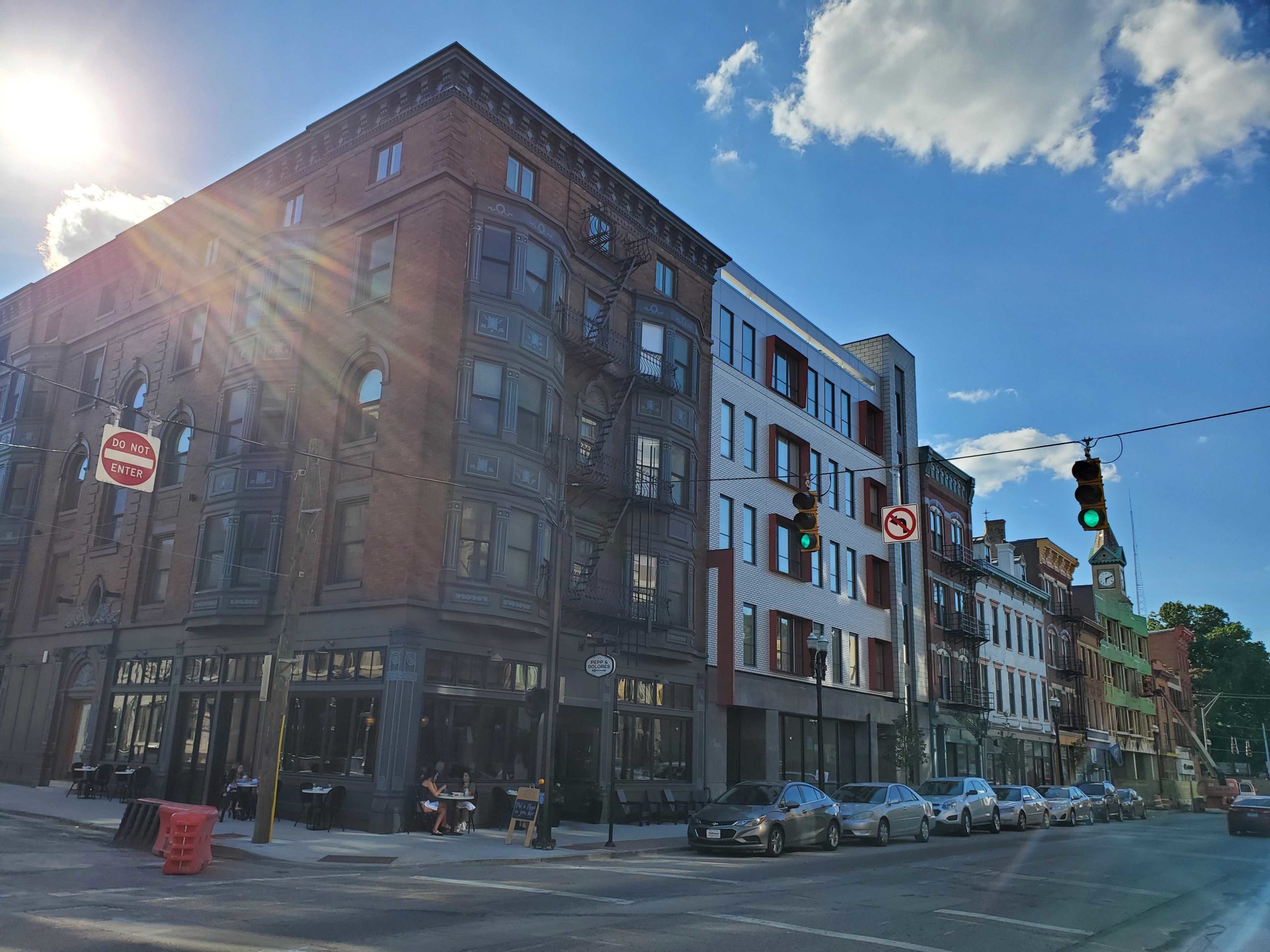
As a white male who has experienced deep privilege over the course of my life, it was important to educate myself on some of the history of the places we were passing through – particularly in the South. On our way from New Orleans to Atlanta, we made several stops at Civil Rights landmarks in places like Meridian, Mississippi and the Birmingham Civil Rights National Monument. The latter is home to an array of powerful statues and plaques commemorating the events of May 3rd, 1963, when top cop “Bull” Connor ordered his men to attack peaceful protesters and children with dogs, water cannons, and more. This was a horrific milestone and a turning point in the 1960s Civil Rights movement when images were published in the New York Times the following day. We also visited the tomb of Dr. Martin Luther King, Jr. and Coretta Scott King, which is located in “Sweet Auburn,” the neighborhood of Dr. King’s youth, and explored the National Center for Civil and Human Rights in downtown Atlanta, which powerfully linked Civil Rights history with the global inequities and injustices of the modern age. It was rather shocking how much of the history I had not been taught in class, and how much the framing of what I was taught differed from many of the personal accounts documented across these places of power.
Native American and Indigenous history was also a throughline of the trip, but it is deeply dismaying to see the lack of government recognition of the extermination and displacement of Native people across the country. It was particularly frustrating to see the vast majority of the items for sale in National Park gift shops being from non-Native sources. As we traveled from Detroit to Chicago, we stopped in Western Michigan to meet up with an old friend of my father who is an Elder in the Potawatomi Tribe of the Great Lakes area. We visited his Tribe’s highly successful casino and learned about how Tribes interact with the Federal government – gaining a deeper understanding of how tribal relationships with the Feds remain fraught, even today. It was a privilege to travel and learn this firsthand.
I haven’t processed the totality of my road trip experience, but it has given me a fresh layer of perspective on the work of Valley Vision and our many partners – including many of you reading this today. Your work and my work to make communities more livable is what it’s all about. We are attempting to solve the messy problems of our age, and doing it with a reverence for the past but also an excitement for what is to come. The desire to achieve this balance, while continuously learning and building trust, provides the energy and motivation to keep doing consistently challenging and sometimes thankless work to better our communities. We’ll continue to find our sweet spot as we collaborate on bold solutions that improve people’s lives – I hope you will too!
To keep up with Valley Vision’s work to advance livability in the Sacramento region, subscribe to our Vantage Point email newsletter!
Adrian Rehn is a Valley Vision Project Leader overseeing the Cleaner Air Partnership, Sacramento Neighborhoods Activating on Air Quality, and Valley Vision’s online communications. He can be reached at adrian.rehn@valleyvision.org.
Hybrid Work: The Disruption of 2021

With June 15th passing this week, marking California’s first opening since the pandemic hit, returning to the office and creating hybrid work environments is front of mind for many employers and employees. Microsoft Worklab published a recent report on hybrid work as the next big disruption – what are the big trends, how are they playing out in our region, and where do we go from here?
1. Flexible work is here to stay
Many workers got to experience remote work for the first time and don’t want to leave the positives of the experience behind. Nationwide, 70% want to retain a hybrid model although many are also clamoring for in-person time with their teams. In our region, the COVID-19 Resilience Poll tells us that 63% of workers worked full-time in office before the pandemic but 69% want a hybrid model now to avoid commutes and maintain more flexible hours.
2. Leaders need increased connection to workers
A recent study shows that business leaders are faring better than their employees throughout the pandemic with 61% saying that they are thriving while only 38% of those without decision-making authority say the same. Further, disparities in pandemic impacts are contributing to a divide – younger workers, workers of color, and women have struggled through the pandemic more intensely than others and are less likely to be in leadership roles at work.
3. High productivity is masking an exhausted workforce
Anecdotally, companies are reporting high productivity this year with commute, travel time and distractions of the office eliminated. Microsoft data shows that chats, emails, meetings, and time spent in documents have significantly increased between February 2020 and February 2021. It also shows that 54% of workers feel overworked and 39% feel exhausted. Digital overload and increased isolation are seriously taxing workers.
4. Gen Z is at risk and will need to be re-energized
Gen-Z, or those between 18-25 years old, are feeling these effects the strongest. 60% of Gen Z are merely surviving or flat-out struggling right now. This age demographic reports struggling to get new ideas on the table, get a word in during meetings, and feel excited or engaged about work. Because they are younger, often single, early in career, and less financially stable – isolation, network connections, and meaningful engagement has been much harder during the pandemic. The COVID-19 Poll found that in our region these factors and others contributed to higher rates of stress, anxiety, and depression for our younger respondents.
5. Shrinking networks are endangering innovation
The pandemic shrunk our worlds – both personally and professionally. Research shows that interactions with our close networks increased while our interactions with our more distant networks decreased. This reduces the inflow of new ideas, stifling innovation.
6. Authenticity will spur productivity and wellbeing
2020 was the year that home life was made visible at work – children, pets, and personal spaces came with many of us to our virtual meetings and as a result we had the opportunity to see each other as full humans in ways that never came through in routine office life. Additionally, our shared vulnerability of going through a tough time together bonded co-workers in new ways.
7. Talent is everywhere in a hybrid work world
The pandemic accelerated the notion that we can work from anywhere – and that is exactly what many workers want to do. A study from LinkedIn reports that remote job postings increased five-fold and 46% of workers say they want to move this year, anticipating continued remote work opportunities. Remote work can increase access to job opportunities for underrepresented groups – the same study found that women, Gen-Z, those without a graduate degree are more likely to apply for remote work and women, Black, and Latino workers are more likely than white men to prefer remote work. People are at inflection points in their careers with 41% noting that they’d like to leave their job within the year. In Sacramento County, 40% of jobs are remote eligible by function, as reported by the Bay Area Council Economic Institute. Additionally, the trend is that people in high cost areas are moving to lower cost areas – translating to an influx of Bay area residents to our region, a spike in real estate prices and growth in our professional workforce.
The trends are clear – we are in the midst of major disruption and transition to different ways of doing work. There are some clear recommendations for both employers and the region at large:
Empower workers to be able to work in office or remote environments: a mix of both will result in flexibility, productivity, and increased connection and collaboration. Just as employers pivoted to remote, now is the time to pivot again to safely open offices and create a new type of environment that embraces hybrid work where possible. Solutions should address technology tools, office design, home accomodation, and policy practices that maximize hybrid options.
Combat digital exhaustion starting from the top: Leaders need to understand the challenges of workers and actively promote a culture that encourages strong work/life boundaries and downtime. Organizations and companies need to strengthen diversity, equity, and inclusion practices and policies to address the intersectional burdens that people of color and other underrepresented groups face at work.
Rebuild our collaborative fabric: Isolation and smaller networks have marked 2020 and 2021 so far. Expanding networks, building collaborative opportunities and environments, and reacquainting with more distant networks (slowly for introverts!) will be a key activity of 2021.
Enhance employee experience to attract talent: While workers are reconsidering career, location, and the opportunity landscape, employers must cultivate a diverse, inclusive, and flexible culture to attract top talent.
By maximizing the positives of the remote work experiences that we have experienced while mitigating the isolation and digital overload of the past year, 2021 is an opportunity to build stronger, more resilient organizations and businesses to support a trhiving, healthy, and innovative workforce.
To keep up with Valley Vision’s work to advance livability in the Sacramento region, subscribe to our Vantage Point email newsletter!
Evan Schmidt is Valley Vision’s Chief Executive Officer.
Spring Advisories: Preparing our Regional Workforce for Success
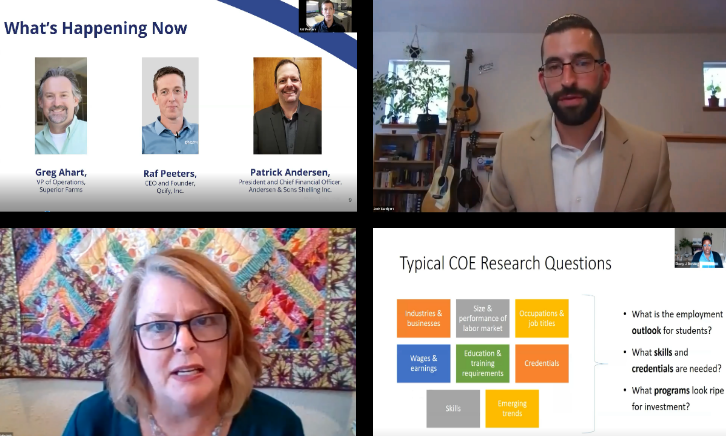
April 2021 was a month filled with dynamic industry discussions for Valley Vision, as it hosted three Regional Industry Advisories funded by Los Rios Community College District Strong Workforce Program and in partnerships with Sierra College, Yuba Community College District, and the Capital Region workforce boards. The Advisories’ objectives included building strong relationships between employers, educators, and workforce partners that provided timely information on skills gaps and opportunities for more ongoing engagement. April’s advisories served to foster workforce pipelines into the Sacramento Region’s diverse sectors, some of which have been especially harmed by the ongoing COVID-19 pandemic. However, as emphasized throughout the Advisories, the region’s workforce partners can play a strong role in meeting industry demand for a skilled workforce that helps industries pivot and thrive.
The month’s series of virtual Advisories began with Retail, Hospitality, and Tourism (RHT), an industry especially hard hit by the COVID-19 pandemic, but in recovery. Keynote Speaker Mike Testa of Visit Sacramento shared an optimistic re-opening of Sacramento’s RHT industry and its benefits for the region, saying “This isn’t just about the City of Sacramento – it’s about everybody else“. An Industry Insights Panel featuring employers followed, emphasizing how businesses pivoted with COVID-19 and their demand for a diverse RHT workforce that possesses critical thinking, emotional intelligence, and communication skills. Afterwards, Dr. Robert Eyler offered an engaging presentation on economic and policy conditions behind the RHT industry. For a more detailed look at the Advisory, take a look at our separate blog on the event here!
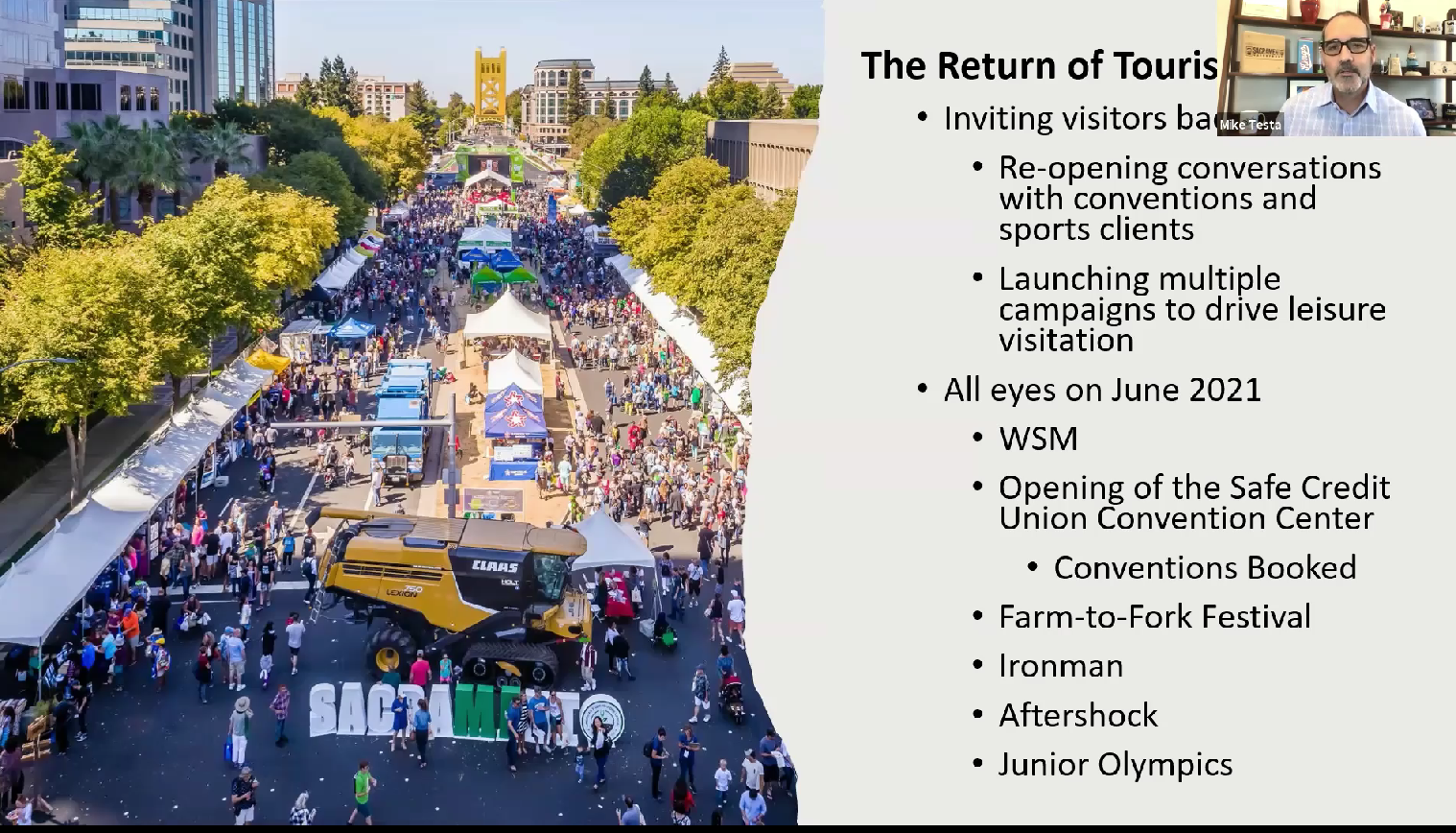
Next was a Regional Industry Advisory on Gerontology, Geriatrics and Business Services in the Field of Aging, which began with a presentation on shifting demographics and occupational data by North/Far North Center of Excellence Research Manager, Ebony Benzing. This data further informed industry insights provided by keynote speaker Leading Age California President and CEO, Jeannee Parker Martin, and the employer panel on arising issues in the field. Towards the end of the event, American River College’s Gerontology Department Chair and Career Education Program Coordinator, Laurinda Reynolds, presented on ageism and interventions that could promote careers in the field.
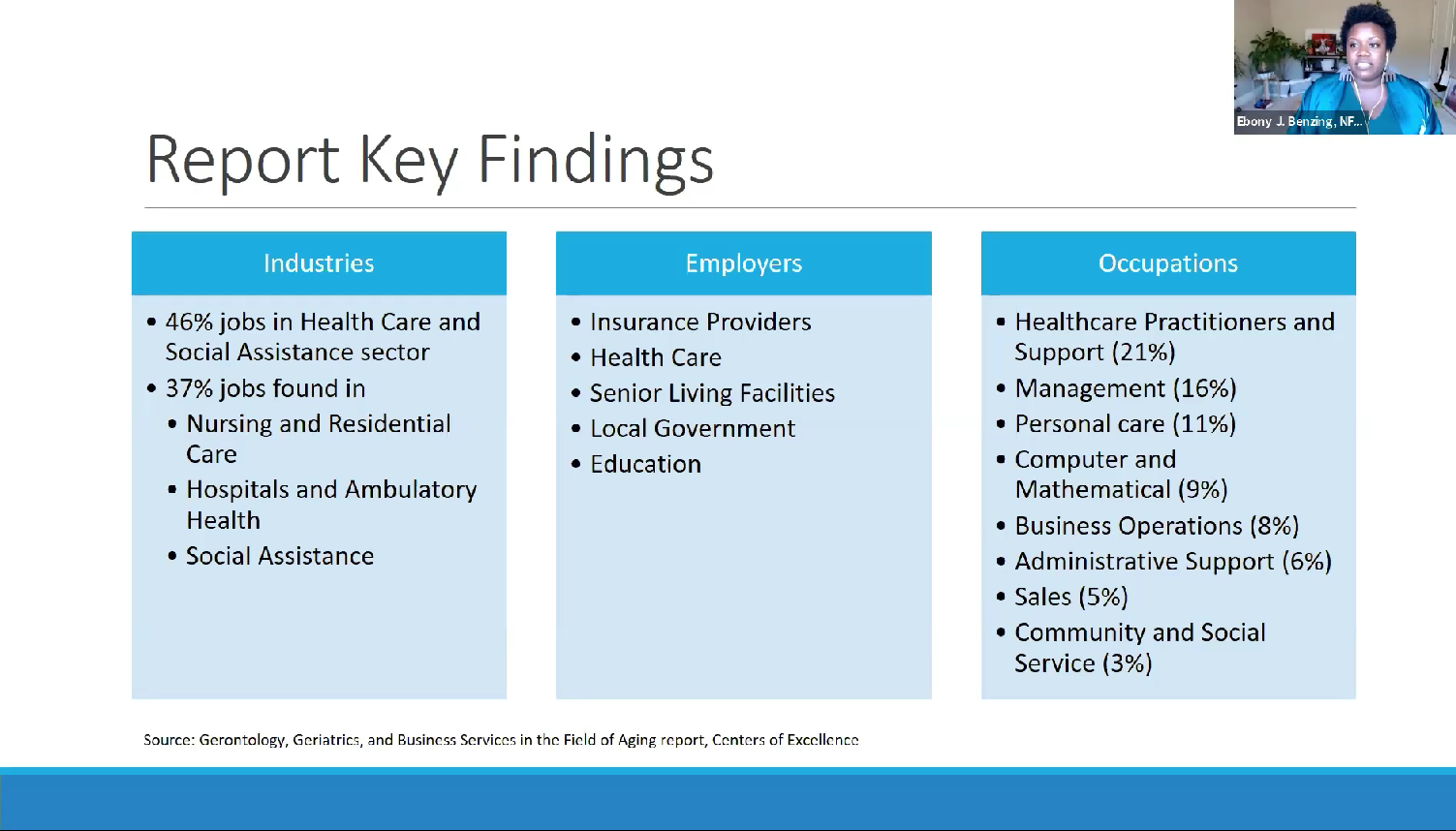
The month’s Advisories finished off with a cross-sector look at Automation & AI in Agriculture and Manufacturing. The event uniquely featured two industry panels, one focusing on current employer needs and the second focusing on the future of automation in food processing. “There’s a common theme when you walk into a processing plant… how can we keep the plant running, with limited supply of people who are available? That is the biggest challenge,” described Raf Peeters, CEO and Founder of Qcify, Inc. and one of the Advisory’s employer panelists. Employers went on to describe the need for workers who can operate this automation and AI technology, which workforce partners can assist with through course development and trainings
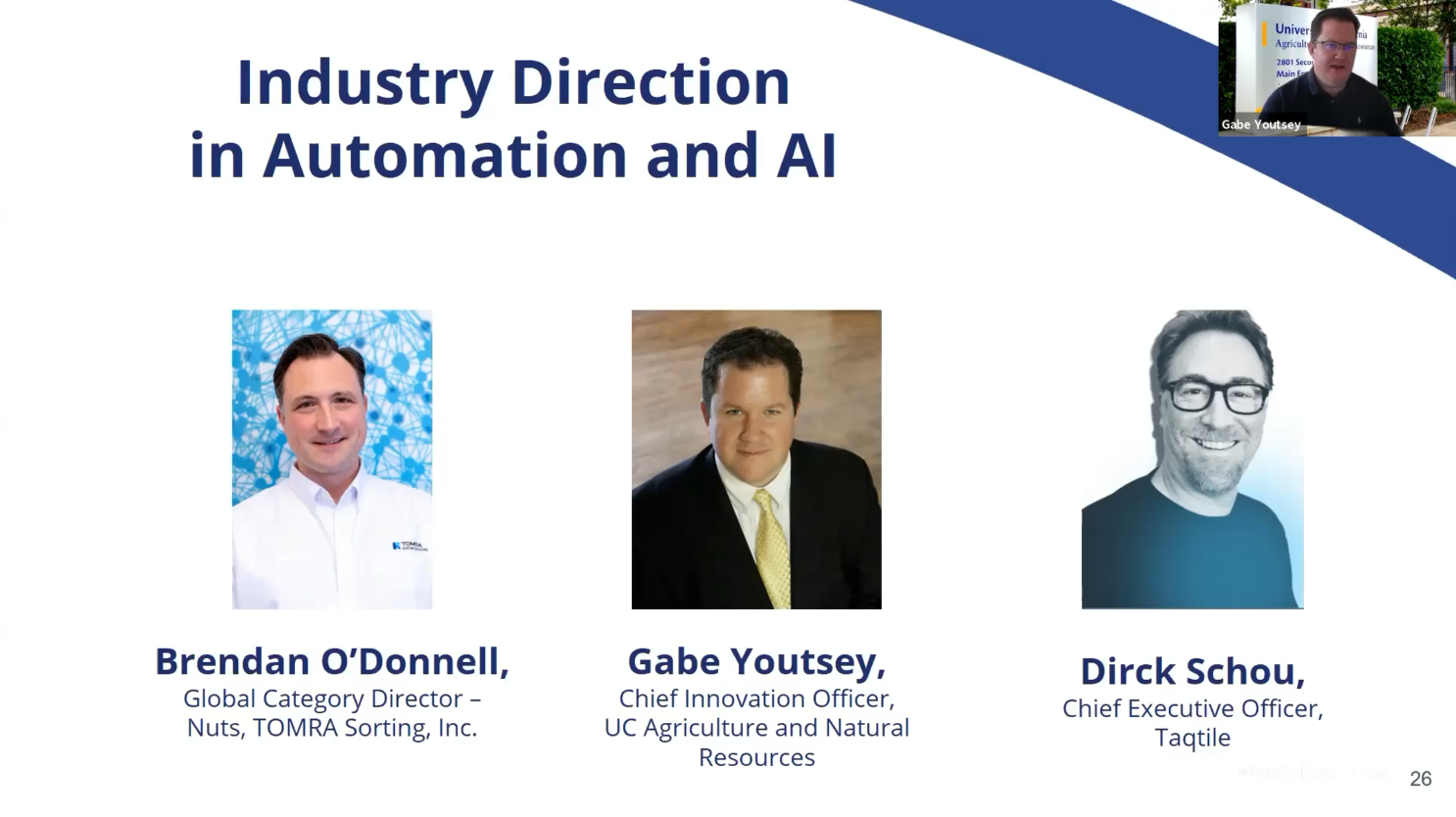
By the end of April, Valley Vision and its community college and workforce partners had successfully facilitated a wide range of opportunities for employer engagement to inform curriculum development. The ongoing pandemic’s toll on Sacramento Region industries has made it increasingly important for workforce pipelines to be responsive to employer and worker needs. These needs have been carefully documented by Valley Vision staff throughout its 2020-21 academic year advisories, which included data-driven presentations and employer discussions on the following sectors:
- Advanced Manufacturing
- Agriculture, Water, and Environment Technologies
- Business and Entrepreneurship
- Energy, Construction, and Utilities
- Health Services
- Information and Communication Technologies
- Retail, Hospitality, and Tourism
Additional information on advisories can be found via the links above. Valley Vision and the Sacramento Region’s workforce stakeholders greatly appreciate the attendees who have contributed their valuable insights into the curriculum development process.
To keep up with Valley Vision’s work to advance a future-ready workforce in the Sacramento region, subscribe to our 21st Century Workforce email newsletter!
Jesse Flores is a Valley Vision Project Associate supporting initiatives within the 21st Century Workforce and Clean Economy impact areas.
Retail, Hospitality and Tourism Headed Toward Recovery

While many different industries and sectors bore the brunt of the impacts of the past year’s pandemic, few were as impacted as Retail, Hospitality and Tourism (RHT). As we look forward to a post-pandemic world, what will the future of these industries look like in our region?
On April 16th, Valley Vision, in partnership with the Los Rios Community College District, and in collaboration with Sierra College, Yuba Community College District and the Capital Region workforce boards, held a Regional Advisory on Retail, Hospitality, and Tourism occupations and careers. Regional Advisories provide forums for industry and employer representatives to discuss their current and expected skill needs with educators and workforce system stakeholders. These advisories, funded by Strong Workforce Program, ensure community college and workforce training programs are responding to industry needs, preparing students and community members for the continuously evolving world of work.
The advisory began with Mike Testa, President and CEO of Visit Sacramento, providing an encouraging forecast. He discussed multiple events and campaigns scheduled to draw visitors back to our region including Farm-to-Fork Festival, Tower Bridge Dinner, Ironman Triathlon, Aftershock Music Festival, and Junior Olympics in 2022. The anticipated reopening of the Safe Credit Union Convention Center will also be a huge draw for visitors and conference attendees. Visit Sacramento looks beyond simply boosting the economy, and providing jobs as the city reopens according to Testa, “At Visit Sacramento, internally we say that tourism isn’t about the tourist – it’s about driving revenue for the residents that live here. The money that comes in improves the lives of our residents.”
Next up, Dr. Robert Eyler, President of Economic Forensics and Analytics, Inc., provided a look at the changing dynamics in these industries over the last year and projections for recovery. Examining from a macro lens, he described how the hospitality industry in California displayed the most dramatic job loss, at nearly 30% loss of employment since March of 2020. While a handful of sub-sectors within the Retail industry profited during the pandemic, including e-commerce, retailers selling building or gardening materials, and food or beverage retailers, the majority of the industry suffered job losses from 2.6% to 18.6%. Dr. Eyler remarked that while the past year for the RHT sector has been grim, Summer 2021 hints at the beginning of recovery for restaurants and retail with travel picking up in 2022 and 2023, and full recovery (pre-COVID levels) expected by 2024 or 2025.
Several regional employers participated in the panel discussion including: Tim Stallings – Sacramento Republic Football Club; Bahar Abullarade – Raley’s Supermarkets; Alycia Harshfield – California Restaurant Foundation; Bobbin Mulvaney – Mulvaney’s Building & Loan Restaurant; and Lynn Mohrfeld – California Hotel and Lodging Association. They shared the ways COVID-19 affected their businesses and delved into the types of skills and knowledge students and individuals interested in joining the RHT sector will need. The panelists unanimously agreed that emotional intelligence skills – often known as “soft skills” – were crucial indicating candidates who possess critical thinking skills, interpersonal skills, and the ability to effectively communicate are highly sought after. In the digital age of the pandemic, panelists explained that most of their workers quickly adapted to technological changes, but struggled when it came to effectively connecting with their clientele and fellow staff members. The employer panel also stressed the importance of team-building, working collaboratively, and the ability to work with diverse groups.
While the pandemic has brought with it a continuous wave of uncertainty, the promising projections from Mike Testa and Dr. Eyler, along with accounts of resiliency and adaptability from industry representatives, provided an encouraging picture of a sector headed toward recovery. Even within an increasingly technological age, this advisory has shown the way to be successful in RHT occupations and careers is to embody key parts of the industry itself – forming connections, working together, and serving your community.
To keep up with Valley Vision’s work to advance a future-ready workforce in the Sacramento region, subscribe to our 21st Century Workforce email newsletter!
Caitlin Blockus is a Valley Vision Project Associate supporting initiatives within the 21st Century Workforce impact area.
What Are You Hopeful for in 2021?

A year of deep challenges has come to an end, and a new year is upon us. Read on for thoughts and predictions that Valley Vision staff hope will come to pass in 2021:
Meg Arnold: “I’m hopeful for transitions: swiftly, to vaccines; smoothly, to the new administration; happily, back to seeing people in person without worry, and (on a personal note) successfully, for the four young adults in our home who will all be starting or resuming their four-year degree programs in the fall.”
Isa Avanceña: “I’m hopeful for opportunities for our communities to come back stronger than ever. It won’t be easy, but I believe our region has what it takes. I’m also looking forward to lots of in-person quality time with family and friends, especially in the second half of the year.”
Kari MacDonald: “I am hopeful that we spend 2021 remembering what is truly important: health, love, family, work-life balance, using technology for connection, and good books!”
Houa Vang: “I am hopeful for great prosperity in health, compassion, and growth for everyone in 2021.”
Grace Kaufman: “I’m hopeful for continued health, colorful sunrises and sunsets, new friendships, and quiet reflection.”
Alan Lange: “Globally, I’m hopeful that everyone will take time to fully appreciate the good things that are in their lives. Personally, I’m hopeful that the deluge of house projects I’ve been assigned by my boss (aka spouse) over the past few months will slow so I can have a free weekend (Love you, K!).”
Evan Schmidt: “I’m hopeful for a better 2021 than 2020! This includes: health and well-being for all, the opportunity to create systems and communities that are better than what came before, the ability to visit family that lives long distance, and to go to a fun party by the end of 2021!”
Trish Kelly: “That 2021 sees restored health; economic recovery and renewal that is truly inclusive, starts to remediate past injustices and structural disparities, and sees our region leading around environmental innovations. And that we will be able to see and hug loved ones.”
Renee John: “I am hopeful we will all be kinder to each other, think of each other first and ourselves less.”
Jesse Flores: “I’m hopeful for the opportunities to channel built-up energy and motivation from 2020 towards a more racially equitable Sacramento region.”
David Espinoza: “I am hopeful to continue witnessing high-quality and affordable internet service expanding across the region. I am hopeful for good health and unity in the country and the world. I am hopeful to become better acquainted with the beautiful and amazing Greater Sacramento Region and for new adventures here with my family. Live long and connected, and may the broadband be with you.”
Adrian Rehn: “I hope for a better and brighter 2021 where people’s basic needs are provided for.”
To keep up with Valley Vision’s work to advance livability in the Sacramento region, subscribe to our Vantage Point email newsletter!
A Tense Week

This has been a tense week and there is much that we don’t know. We still don’t know the outcomes of many elections, including who the next U.S. President will be. We also face a higher degree of uncertainty than we normally might after an election season, regardless of the outcomes. There may be tumult as we look into the next few months, with pandemic numbers on the rise, new leaders and policies coming in on national, state, and local levels, and intense community hardships and ongoing divisions occurring in our communities.
There are some things that we do know. We know that the divisions that we see nationally are also reflected here in our region. We see a microcosm of the red and blue patchwork in our region as we do in the nation – with our urban core, including most of Sacramento, Yolo, and Placer counties, leaning Democratic while many of our suburban or rural communities, especially El Dorado, Yuba, and Sutter counties, leaning Republican. Across the region, we see 50/50 splits on liberal/conservative candidates and issues, just like in the nation as a whole. We learned in our recent COVID-19 Resilience Poll that people in the region are losing a sense of goodwill for government and institutions on the national, state, and local levels. So, knowing that uncertainty and division remain, where do we go from here?
We focus on what we know needs to be done and we keep working. We saw from our recent COVID-19 Resilience Poll that people and communities are suffering from the effects of the pandemic – including struggling to afford basic necessities, experiencing depression and anxiety as well as threats to physical well-being, feeling stress from balancing work and home demands, and losing goodwill towards government and institutions. We also know that the effects are being experienced much more intensely for people of color in the region and that younger adults are carrying a heavier burden in many cases.
Beyond knowing that hardships are happening, we also have a sense of where people need support. Affordable housing, access to jobs, extra support for people and businesses who have lost their livelihood, food access, health care access, and broadband connectivity to name a few. Further, we must find the bridges that enable us to work together on the things that matter most. Data-driven action to build common purpose. Listening to and empowering diverse community voices in leadership and decision-making. Holding ourselves and others accountable to address the very real struggles in our communities. Building on our strengths and assets across the region. We know what we need to do, even in the face of political division and possible tumult. Now more than ever, we need to keep working on the issues that matter to build resiliency, equity, health, and prosperity in our communities.
To keep up with Valley Vision’s work to advance livability in the Sacramento region, subscribe to our Vantage Point email newsletter!
Evan Schmidt is Valley Vision’s Chief Executive Officer.
The First 90 Days

As of this week, I’ve been in the position of CEO of Valley Vision for 90 days – which is often counted as a milestone for a new job. During these 90 days I’ve focused on learning the job; engaging with community partners, stakeholders, Board, and staff; and developing a set of priorities for Valley Vision into 2021. What is my vision for Valley Vision?
1. Deepening Our Commitment to Social and Racial Equity
My career focus has always been on strengthening equity in communities – from early in my career working on gender equity to the many projects I’ve advanced at Valley Vision that create equitable opportunities. As CEO, it is important to me that Valley Vision’s commitment to social and racial equity be authentic and apparent through our actions. In July, the Valley Vision staff team participated in a Whiteness at Work web series to examine how dominant white culture and anti-Black culture impacts our staff, teams, and work in and for the community. We ended the series with new resources, a new staff-led Equity Subcommittee, and an identified set of actions to cultivate inclusion and equity within our staff and through our work. We are starting with ourselves – building trust, team cohesion, and a common set of values that are foundational to our work. Our goal is to develop our own framework to advance operationalizing equity in our organization and throughout our work.
2. Visionary Planning and Investment Strategies
Valley Vision’s role in the region is to set our eyes on long-term solutions to create economic prosperity, social equity, and environmental sustainability in the region. To do this, Valley Vision is known for advancing research, fostering collaboration, and catalyzing action. We also need an engine to achieve needed investment to solve our region’s larger challenges. Therefore, Valley Vision is engaging in more intentional investment planning including working with community leaders and partners to create comprehensive, co-designed strategies which will create project and investment-ready coalitions to advance bold solutions. We have an opportunity to meet our region’s greatest challenges together through ambitious, co-owned solutions that will position our region as one of the most livable in the nation.
Our first focus is on developing an investment strategy to advance digital inclusion in the region by expanding broadband infrastructure and connectivity, supporting access to needed technology for all, and advancing digital skills for the workforce. We are already co-leading the Sacramento Coalition for Digital Inclusion with other partners to create the systems, tools, and skills needed for all to fully participate in civic life, education, and work. Reaching our long-term solution to truly create digital equity in the region will require a big-umbrella vision to inspire investment — because if we don’t know where we are going, how will we get there?
3. Creating Actionable Research and Sharing Our Insights
Our region and communities are transforming more rapidly than in generations. Between coronavirus, effects of climate change, upcoming elections, the pace of technology change and adaptation, and more – life has never been so complex. That is why it is more essential than ever to have the data and information needed to adapt, recover, and reimagine our future. There are a few main areas where we will grow our research capacity by focusing on actionable research and advancing a commitment to sharing best practices.
- Actionable Research: We believe that decisions should be informed with data and we are expanding our capacity to create actionable research. We have already built two new partnerships in the last six months to be able to do just that – Capital Public Radio for our polling initiative and Burning Glass Technologies to analyze rapidly changing workforce needs. We’ve also hired Dr. David Espinoza to manage the Connected Capital Broadband Consortium – bringing his GIS and other analytical expertise to our team.
- Sharing Lessons Learned: Valley Vision’s ability to collect and analyze unique data for the region is one of our key strengths. We generate a tremendous amount of data and lessons learned at Valley Vision, but it has not always been our regular practice to slow down in order to share the unique data and the stories from the field that we have collected. I’m very committed to reporting out regularly as well as connecting with other publications and networks to share our work, insights, and recommendations.
The Valley Vision I envision is an inclusive organization with clear values around equity; is action-oriented, collaborative, and poised to do big things; and is always pushing forward to find new information, connect the dots, and support data-driven decision-making in our region. Let’s get to work.
To keep up with Valley Vision’s work to advance livability in the Sacramento region, subscribe to our Vantage Point email newsletter!
Evan Schmidt is Valley Vision’s Chief Executive Officer.
New Greater Sacramento Region Comprehensive Economic Development Strategy (CEDS) Approved by U.S. Economic Development Administration
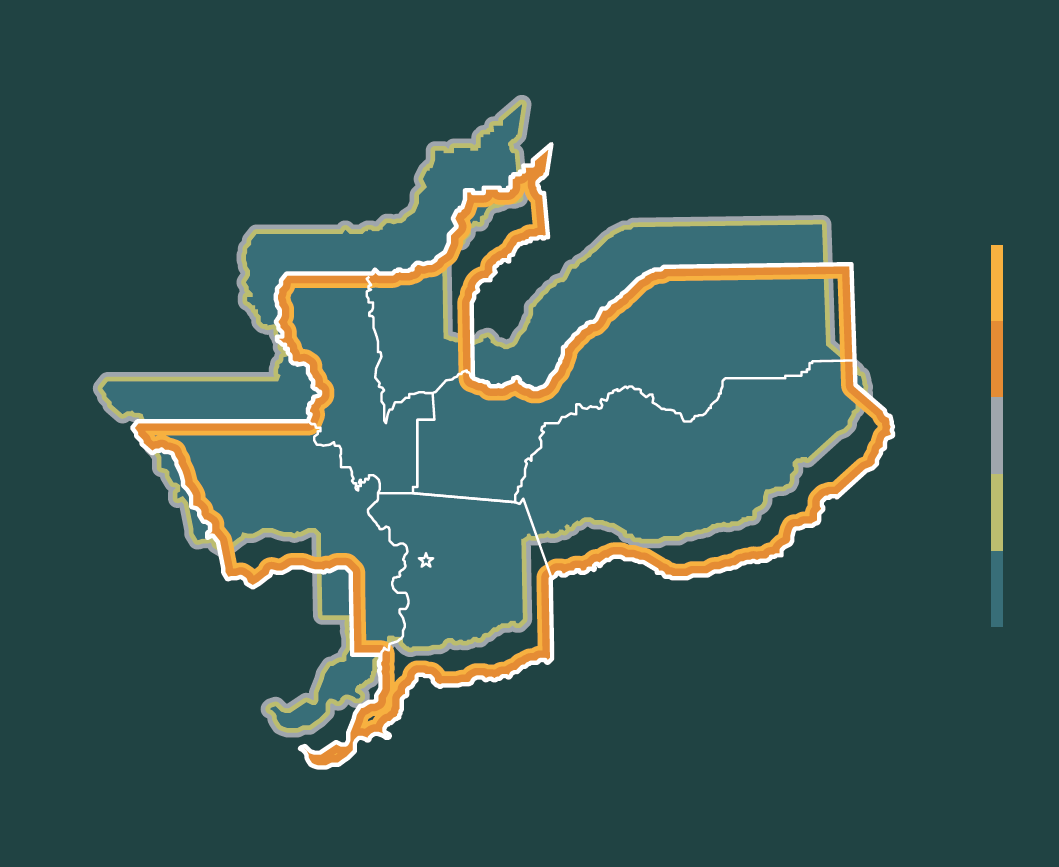
Valley Vision is extremely pleased to report that the Economic Development Administration (EDA), U.S. Dept. of Commerce, has officially approved the Greater Sacramento Region’s Comprehensive Economic Development Strategy (CEDS), known as the Prosperity Strategy. It will be current for five years and provides eligibility for EDA funding for its many programs supporting regional economic resiliency, innovation and recovery, across the six-county region.
The CEDS is the culmination of two years of intensive collaborative research and strategic planning led by a partnership of the Greater Sacramento Economic Council, the Sacramento Metro Chamber of Commerce, the Sacramento Area Council of Governments (SACOG), and Valley Vision, with funding support from EDA. Building upon a call to action from an assessment of the regional economy by the Brookings Institution in 2018, the CEDS contains six core strategies and related initiatives, within a framework of inclusive economic development to drive equitable and sustainable prosperity. The CEDS also follows upon the foundation built by the previous CEDS, Next Economy.
We’re grateful to the more than 400 community leaders and representatives across the region who contributed their valuable ideas, expertise and guidance throughout the process, including members of the CEDS Steering Committee. The CEDS is a living document, meant to be updated to reflect current economic conditions, to guide investments toward impactful and meaningful outcomes, and to track progress toward key initiatives and goals. Given the realities of COVID-19, the partners have created a short term “Bridge to Action” for inclusive economic recovery and growth – The Path Forward.
The partners along with the Sacramento Asian-Pacific Chamber of Commerce are committed to advancing the wellbeing of the region through collaborative and shared implementation of the CEDS. EDA will continue to be a valued partner in this process. EDA’s approval letter stated: “We commend your organization and your regional partners for this excellent effort, and we look forward to working with you as you continue to address the economic development planning and implementation needs of the region.” Please click here for the full CEDS and the Path Forward, and contact Valley Vision if you need information on EDA applications and/or letters of support. We welcome your participation and input, so please be in touch as we all work together for the future of our region.
Trish Kelly is Valley Vision’s Managing Director, leading its food, agriculture, workforce, and broadband initiatives.
Those Were the Days…
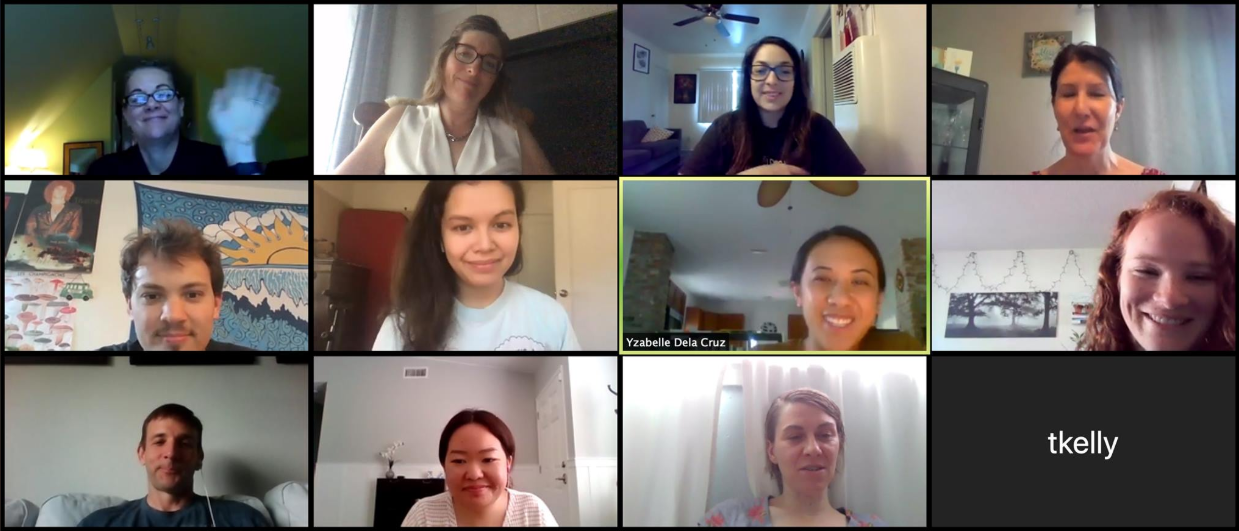
My term as Interim CEO ends on June 30, as the organization welcomes Evan Schmidt as its next CEO. Although it’s been a five-month span, my thoughts about this Interim CEO period are centered on the four weeks beginning in mid-March – that concentrated period of intense upheaval, uncertainty, and ceaseless sudden changes. The memory of what it actually felt like to live those days has ebbed (the same protective mechanism that fades the memory of childbirth, perhaps?). But four strong messages from those weeks continue to stick:
Know the risks but aim for the opportunities. Like all organizations, we quickly conducted some COVID-impact financial stress tests. It’s only prudent, in a time like this, to figure out what bad things might happen and what you would do about them, and the effort gave us good insights. But as important as it is to know the risks, it’s just as important to continue to aim for potential and opportunity. Balancing worry with hope – creating informed optimism – is steadying in unsteady times.
Remote working relationships can be “more real.” Working remotely, we’ve all seen more of each other’s whole lives during these months than before. Not just random portions of our homes, but also the kids, partners, and pets that we share them with. As well, because we were all adjusting to the tumultuous changes at the same time, meetings I was part of paused often to just process, together, the personal impacts of so much change and worry. Acknowledging the whole life that we each have is more complete and honest, even though it’s happening in little Zoom boxes on our screens.
There is strength in working for the collective good. We Americans tend strongly toward values of individualism and independence, yet this virus has reminded us that we are also interdependent and social beings. To a degree not seen in a generation, we have needed to work together, and to make broad societal and personal sacrifices for our collective, species-wide benefit. This has been hard to do, and hard to sustain, but has also been inspiring and confidence-building.
Ultimately, we are all more capable and resilient than we know. Beginning in those weeks of March, we’ve all caught glimpses of the potential and capacity within us all. We all adapted, innovated, and persevered at all the levels of our lives simultaneously, and at breakneck speed. Over the span of days, organizations moved entirely online and remote; businesses closed and laid off employees; parents juggled work and kids simultaneously; families began struggles with unemployment and finances; governments and nonprofits created short-term support programs out of whole cloth and launched them within days; and so much more. Has it been painful, heartbreaking, ugly, and confusing? Without doubt, and none of it would ever be wished for. But even so, and amid such need, we have all been showing our individual and collective spirits, strengths, and abilities.
I am grateful to have been trusted to lead this organization, in this community, during this time, and look forward to what we all continue to accomplish – together.
Meg Arnold is Interim CEO of Valley Vision through June 30.